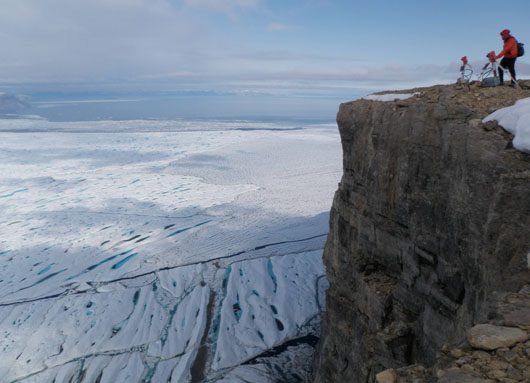Scientists discover ‘record melt’

Dr Bates measuring the melt in Greenland. Photo: Alun Hubbard.
Researchers have discovered a significant ice cap melt in Greenland, recording the biggest indication of climate change to date.
The team from the Universities of St Andrews, Aberystwyth and Ohio State, were ‘amazed, but not shocked’ to monitor the breakup of a huge portion of the floating ice shelf off the front of one of the largest glaciers in the region.
The discovery of the breakup of a 250km sized berg follows a record melt in Greenland accompanied by the large scale breakup and retreat of the ice sheet’s largest outlet glaciers.
University of St Andrews’ researcher Richard Bates joined forces with colleagues Alun Hubbard (Aberystwyth University) and Jason Box (Byrd Polar Research Centre, Ohio State University) to investigate the effects of an abnormally high climate and oceanic warming on ice sheet melt and retreat across Greenland’s most northern coastline.
Despite predicting the breakup of the Petermann Glacier following an earlier visit in 2009, the scientists had not envisaged it on such a vast scale.
Dr Bates commented, “We went up there last year as we suspected that there would be a breakup event in the near future. We believe that the melt water entering these fractures is quite critical to break up together with the warmer oceanic waters that come up from down south throughout the summer.
“It is not a freak event and is certainly a manifestation of warming. This year marks yet another record breaking melt year in Greenland; temperatures and melt across the entire ice sheet have exceeded those in 2007 and of historical records. Jakobshavn Isbrae – the world’s fastest flowing outlet glacier – also experienced a significant melt last month.”
Dr Bates is the geophysicist of the crew, responsible for the geophysical measurements through and around the glacier. At Petermann, this specifically extends to measuring the oceanic conditions in front of the glacier and importantly beneath the glacier along the fractures.

Petermann Glacier is one of Greenland’s largest outlet glaciers which is 20km wide at its front and has a catchment area covering 8% of the entire Greenland ice sheet. It is also the largest floating ice shelf in the northern hemisphere which is fed, like a massive conveyor, by ice flowing from the grounded inland ice sheet.
Deploying time-lapse cameras overlooking the glacier from the top of its towering 900m cliffs, the research team can record the dramatic event and determine whether the breakup has led to a further acceleration and thinning of ice. All going well, the scientists will return later this month to gather recorded data and to carry out further investigations.
Dr Bates continued, “It is very difficult logistically and expensive to get back. The idea at present is to try and sail to close to the glacier with helicopter support on the passage up there and then for getting around when there. It could be a bit tricky doing this as it’s not only a long way but there will be ever increasing ice to negotiate on the way north.”
ENDS
Note to Editors
Dr Richard Bates is available for interview on satellite phone: 00 8816 315 73 992 (for cheaper rates out of the UK dial 0911 448 4488 first) or email [email protected].
Note to Picture Editors
Images of the area and ice cap melt are available from the Press Office – contacts below.
Issued by the Press Office, University of St Andrews
Contact Gayle Cook, Senior Communications Manager on 01334 467227 / 462529, mobile 07900 050 103, or email [email protected].
Ref: Record melt 120810
View the latest University press releases at www.st-andrews.ac.uk
Category Research